Biochemistry - Biological Membranes
1/69
Earn XP
Description and Tags
Chapter 8
Name | Mastery | Learn | Test | Matching | Spaced |
|---|
No study sessions yet.
70 Terms
Cell (plasma membrane)
- semipermeable phospholipid bilayer; chooses which particles can enter/leave cell at any point in time
- composed of 2 layers of phospholipids
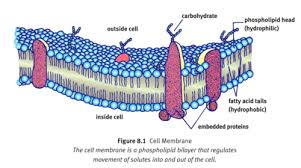
Fluid mosaic model
theory that underlies structure and function of cell membrane & accounts for presence of 3 types of membrane proteins
glycoprotein coat
created by carbs associated with membrane-bound proteins (cell wall has higher levels of carbs)
Cell membranes
- protect interior of cell from external environment
- selectively regulate traddic into/out of cell
- involved in intracellular/intercellullar communication& transport
- contain proteins embedded w/in lipid bilayer
(act as cellular receptors during signal transduction & play important role in regulating/maintaining overall cellular activity)
Phospholipids
move rapidly in plane of membrane through simple diffusion
Lipid rafts
- collections of similar lipids with/without associated proteins; serve as attachment points for other biomolecules & as roles in signaling
Lipids rafts & proteins
travel within plane of membrane, but slowly
Lipids moving between membrane layers
energetically unfavorable ebcause polar head group of phospholipid must be forced through nonpolar tail region in interior of membrane
Flippases
specialized enzymes that assist in transition or ‘flip‘ between layers
Dynamic changes in concentraion of membrane protein
mediated by gene regulation, endocytotic activity, & protein insertion
[cells up/down-regulate number of specific cellular receptors on surface in order to meet cellular requirements]
Fatty acids
carbozylic acids containing hydrocarbon chain & terminal carboxyl group
[chains can be saturated or unsaturated]
Triaglycerols (triglycerides)
storage lipids involved in human metabolic processes
- contain 3 fatty acid chains esterified to glycerol molecule
Unsaturated fatty acids
- ‘healthier‘ fats because they have one or more double bonds & exist in liquid form at room temp
- in plasma membrane; these characteristics impart fluidity to membrane
- humans can only synthesize few unsaturated fatty acids, rest come from intestine inside chylomicrons
- a-linolenic acid & linoleic acid (essential fatty acids)
Saturated fatty acids
- main components of animal fats, tend to exist as solids at room temp
- ‘less healthy’; found in processed foods
- when incorporated in phospholipids membranes, decreases overall membrane fluidity
Glycerophospholipid (phospholipid)
- formed by substituting one of the fatty acid chains of triaclglycerol with phosphate group so that polar head group joins nonpolar tails
- hydrophobic interactions = spontaneous assembly into micelles or liposomes
- used for membrane synthesis
- produce hydrophilic surface layer on lipoproteins = very low density lipoprotein (VLDL) lipid transporter
- primary component of cell membranes
- serve structural roles & second messengers in signal transduction
- phosphate group provides attachment point for water-soluble groups = choline (phosphatidylcholine - lecithin) or insitol (phophatidylinositol)
Micelles
small monolayer vesicles
Liposomes
bilayered vesicles
Triacylglycerol & Glycerophospholipid structures
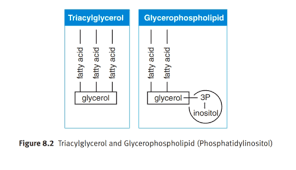
Sphingolipids
- important consituents of cell membranes
- don’t contain glycerol, but sturcture similar to glycerophospholipids (contain hydrophilic region & two fatty acid-derived hydrophobic tails)
- various classes differ in identity of hydrophilic regions: ceramide, sphingomyelin, cerebroside, ganglioside
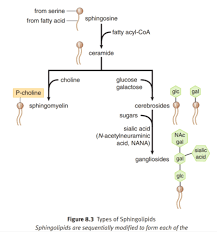
Cholesterol
- negative health effects
- regulates membrane fluidity
- necessary in synthesis of all steroids (derived from cholesterol)
- large ratio of cholesterol to phospholipid = membrane remains fluid [50-50]
Cholesterol structure
- similar to phospholipids; contain hydrophilic & hydrophobic region
- occupies space between adjacent phospholipids to stabilize = prevents formation of crystal structures in membrane
- lower temp: increased fluidity
- higher temp: limits movement of phospholipids within bilayer = decreases fluidity & helps hold membrane intact
- by mass, composes ~20% of cell membrane
- by mole fraction, composes ~50% of cell membrane
Waxes
- class of lipids
- extremely hydrophobic
- rarely found in cell membranes of animals, sometimes found in cell membranes of plants
Wax structure
- composed of long-chain fatty acid & long-chain alcohol
= contibute to high melting point of these substances
- in cell membrane: provide stability & rigidity in nonpolar tail region
- serve as an extracellular function in protection/waterproofing
Proteins within cell membrane
Transmembrane proteins (transporters), embedded proteins (cell adhesion molecules), membrane-associated proteins (enzymes)
Transmembrane proteins
pass completely through bilayer
Embedded proteins
associated either with interior (cytoplasmic) or exterior (extracellular) surface of cell membrane
Integral proteins
- both transmembrane & embedded proteins
- associated with interior of plasma membrane; assisted by one or more membrane-associated domains that are partially hydrophobic
Membrane-associated (peripheral) proteins
bound to elextrostatic interactionswith lipid bilayer, at lipid rafts or other transmembrane or embedded proteins, like G proteinsfound in g protein-coupled receptors
transporters, channels, receptors are generally transmembrane proteins
Carbohydrates
- attached to protein molecules on extracellular surface of cells
- hydrophilic; interactions between glycoproteins & water form coat around cell
- act as signaling & recognition molecules
Membrane receptors
- activate/deactivate some transporters for facilitated diffusion & active transport
- tend to be transmembrane proteins; ligand-gated ion channels open a channel in response to binding of spcific ligand
- others participate in biosignaling; G-protein-coupled receptors involved in serveral different signal transduction cascades
- generally proteins, some are carb/lipid receptors (especially in viruses)
Cell-cell Junctions
- cells within tissues form cohesive layer via intercellular junctions
- junctions provide direct pathways of communication between neighboring cells or between cells & extracellular matrix
- comprised of cell-adhesion molecules (CAM)
CAM proteins
allow cells to recognize each other & contribute to propercell differentiation & development
Gap junctions (connexons)
- allow direct cell-cell communication
- often found in small bunches together
- formed by alignment & interaction of pores composed of 6 connexin molecules
- permit movement of water & some solutes directly between cells ~ don’t permit protein transfer
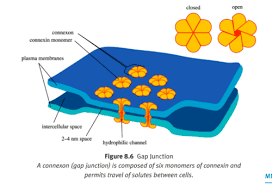
Tight junctions
- prevent solutes from leaking into space between cells via paracellular route
- found in epithelial cells
- function as physical link between cells as they carry single layer of tissue
- limit permeability; create transepithelial voltage difference based on differing concentrations of ions on either side of epithelium
- must form continuous band around cell to be effective (if not, fluid leaks through spaces between junctions)
Desmosomes
- bind adjacent by anchoring to their cytoskeletons
- formed by interactions between transmembrane proteins associated with intermediate filaments inside adjacent cells
- primarily found at interface between two layers of epithelial tissue
Hemidesmosomes
similar function to desmosome:
hemidesmosomes’ main function is to attach epithelial cells to underlying structures (especially basement membrane)
Passive transport
spontaneous processes that don’t require energy (negative delta-G)
- don’t require intracellular energy stores, but utilize concentration gradient to supply energy for particles to move
Active transport
- nonspontaneous processes that require energy (positive delta-g)
- results in net movement of solute against concentration gradient
- energy source can vary
Simple diffusion
- most basic of all membrane traffic processes
- substrates move down concentration gradient directly across membrane
- only particples free ly permeable to membrane
- potential energy in chemical gradient; some energy dissipated as gradient utilized during simple diffusion
Osmosis
- specific kind of simple diffusion that concerns water
- water moves from region of lower solute concentration (higher water concentration) to one of higher solute concentration (lower water concentration)
- Hypotonic, Hypertonic, Isotonic
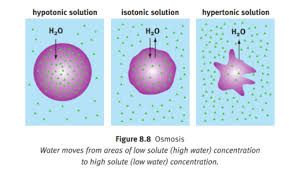
Hypotonic solution
concentration of solutes in cell is higher than surrounding solution
[causes cell to swell as water rushes in = bursting/lysing of cell]
Hypertonic solution
solution more concentrated than cell
Isotonic
solutions inside & outside are equimolar
- doesn’t precent movement; prevents net movement of particles
- water molecules continue to move, cell will neither gain nor lose water overall
Osmotic pressure
- colligative property
- method of quantifying the driving force behind osmosis
Colligative property
physical property of solutions dependent on concentration (not chemical identity) of dissolved particles
[Examples: vapor pressure depression (Raoult’s Law), boiling point elevation, freezing point depression]
Change in water level due to osmotic pressure
Hydrostatic pressure exerted by water level in solute-containing compartment
> will eventually oppose the influx of water
> water level will rise to pont at which it exerts a sufficient pressure to counterbalance tendency of water to flow across membrane
> pressure known as osmotic pressure (II) of solution
II = iMRT

II = iMRT
II = osmotic pressure
i = van’t Hoff factor; number of particles obtained from molecule when in solution
M = molarity of solution
R = ideal gas constant
T = absolute temperature (Kelvin)
Osmotic pressure
- directly proportional to molarity of solution
- depends on presence & number of particles (not actual identity) in solution
- maintained against cell membrane (in cells)
- if pressure created by solutes in cell exceeds cell membrane capacity; lysing
- ‘sucking pressure‘ that draws water into cell in proportion to concentration of solution
Facilitated diffusion
- simple diffusion for molecules impermeable to the membrane (large/polar/charged)
[energy barrier too high for molecules to cross freely]
- requires integral membrane proteins to serve as transporters or channels for these substrates
- examples: carrier or channel protein
Carriers
open to one side of cell membrane at any given point except for occluded state (not open to either side of phospholipid biolayer)
1. substrate binds to transport protein (brief occluded state)
2. remains in transporter during conformational change
3. dissociates from substrate-binding site of transporter
Channels
- transporters for facilitated diffusion
- open or closed confomation
- open: channels exposed to both sides of cell membrane, act like tunnel for particles to diffuse through = rapid transport kinetics
Primary active transport
uses ATP (transmembrane ATPase) or another energy molecules to power transport of molecules across membrane
[maintains membrane potential of neurons in nervous system]
Secondary active transport
“coupled transport”; uses energy to transport paritcles across membrane
- no coupling to ATP hydrolysis
- harnesses enery released by one particle going down electrochemical gradient to drive different particle up gradient
- used by kidneys to, driven by sodium, to reabsorb & secrete various solutes in/out filtrate
symport
both particles flow in same direction across membrance
antiport
both particles flow in opposite directions across membrance
Membrane Transport Processes

Endocytosis
- cell membrane invaginates & engulfs material (in vesicle) to bring into cell
- initiated by substrate-binding to specific receptors embedded in plasma membrane
Pinocytosis
endocytosis of fluids & dissolved particles
Phagocytosis
ingestion of large solids (bacteria)
Vesicle-coating proteins
initiate and carry out invagination
Exocytosis
- occurs when secretory vesicles fuse with membrane; release material from inside cell to extracellular environment
- important in nervous system and intercellular signaling
Membrane potential (Vm)
- difference in electrical potential across cell membranes
[impermeability of cell membrane to ions & selectivity of ion channels = electrochemical gradient between cell exterior & interior]
Resting potential
between -40 & -80 mV
can rise to +35 mV during depolarization of cell
Leak channels
allows ions to passively diffuse through cell membrane
Sodium-potassium pump (Na+ / K+ ATPase)
regulates concentration of intracellular & extracellular sodium/potessium ions
(chloride ions participate in establishing membrane potention as well)
Nernst Equation
used to determine membrane potential from intra/extra-cellular concentrations of various ions
R: ideal gas constant
T: temperature (kelvins)
z: charge of ion
F: Faraday constant

Goldman-Hodgkin-Katz voltage equation
flows from Nernst equation; takes into account contribution of each major ion to membrane potential
P: permeability for relevent ion

Outer mitochondrial membrane
- highly permeable due to many large pores
= allow passage of ions and small proteins
- surrounds inner mitochondrial membrane, with presence of small intermembrane space between the two layers
Inner mitochondrial membrane
- restrictred permeability compared to outer mitochondrial membrane
- contains numerase infoldings (cristae)
- encloses the mitochondial matrix (where citric acid cycle produces high-energy electron carriers used in electron transport chain)
- contains high level of cardiolipin, no cholesterol
Cristae
infoldings that increase available surface area for integral proteins associated with the membrane